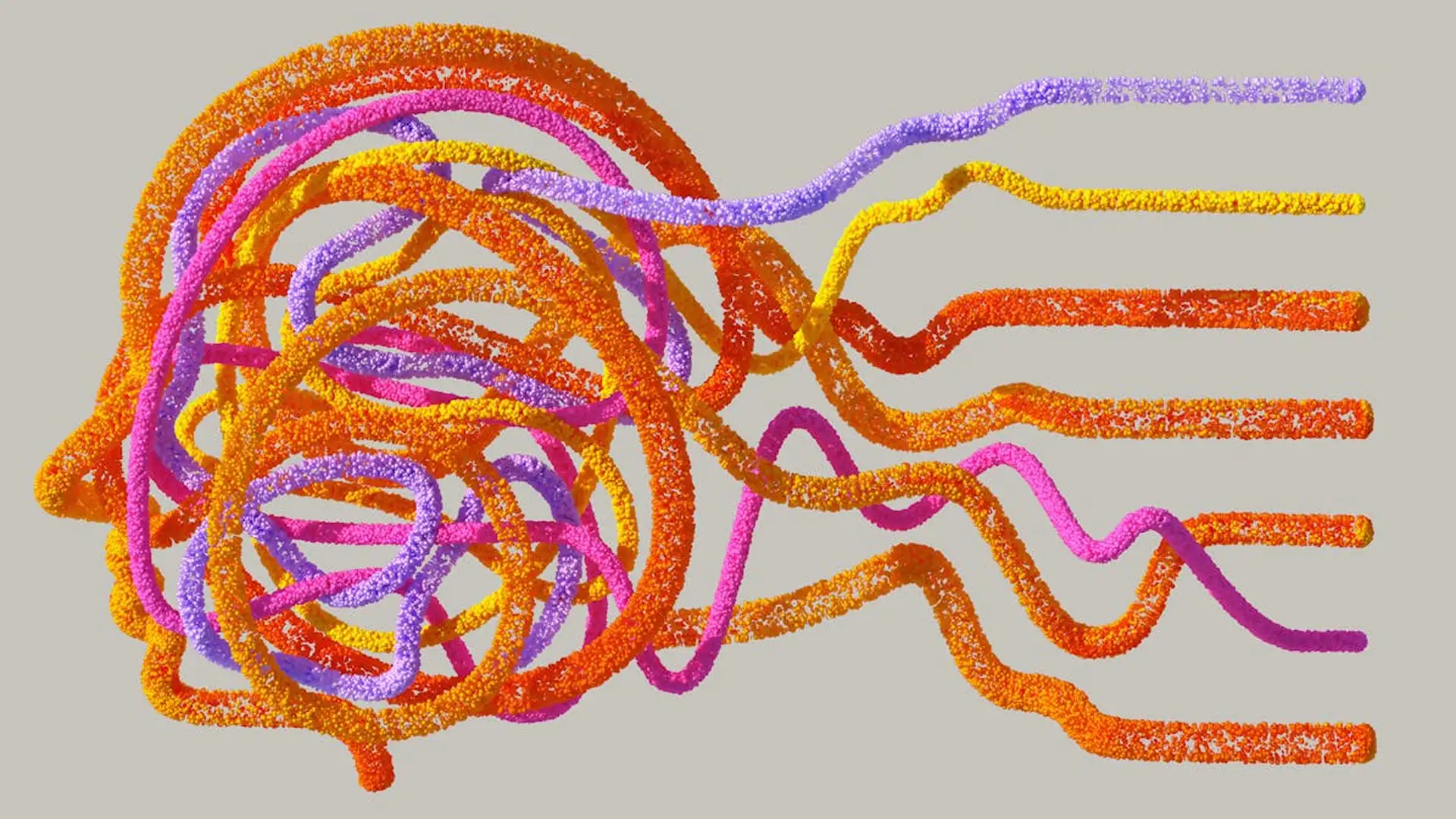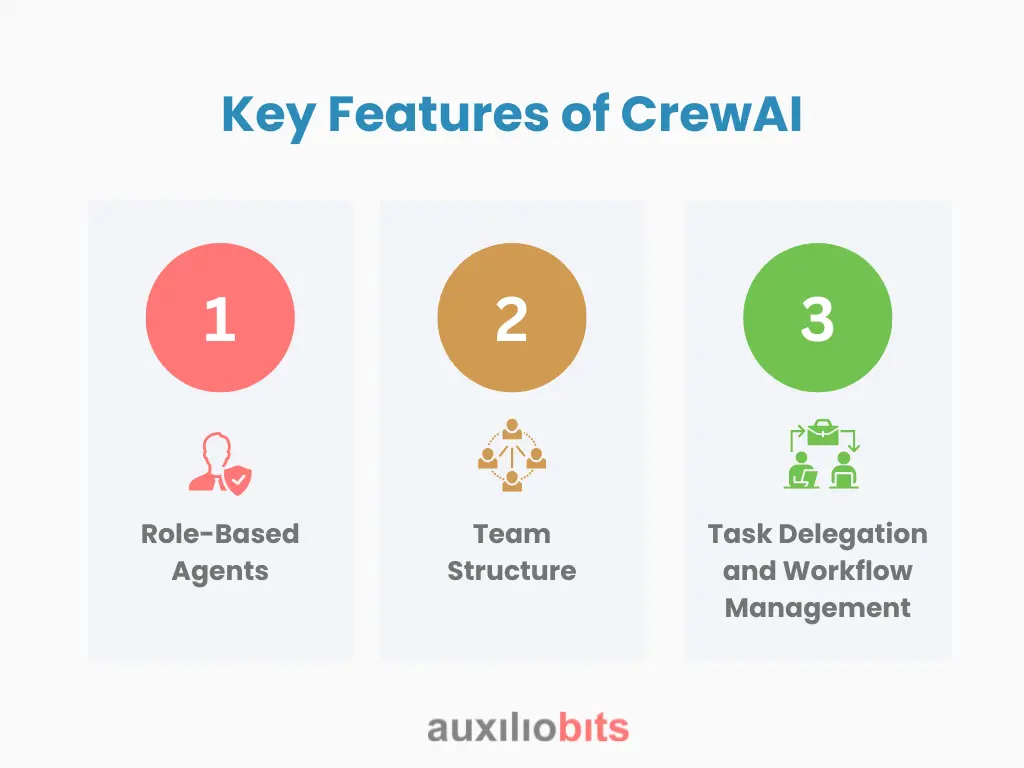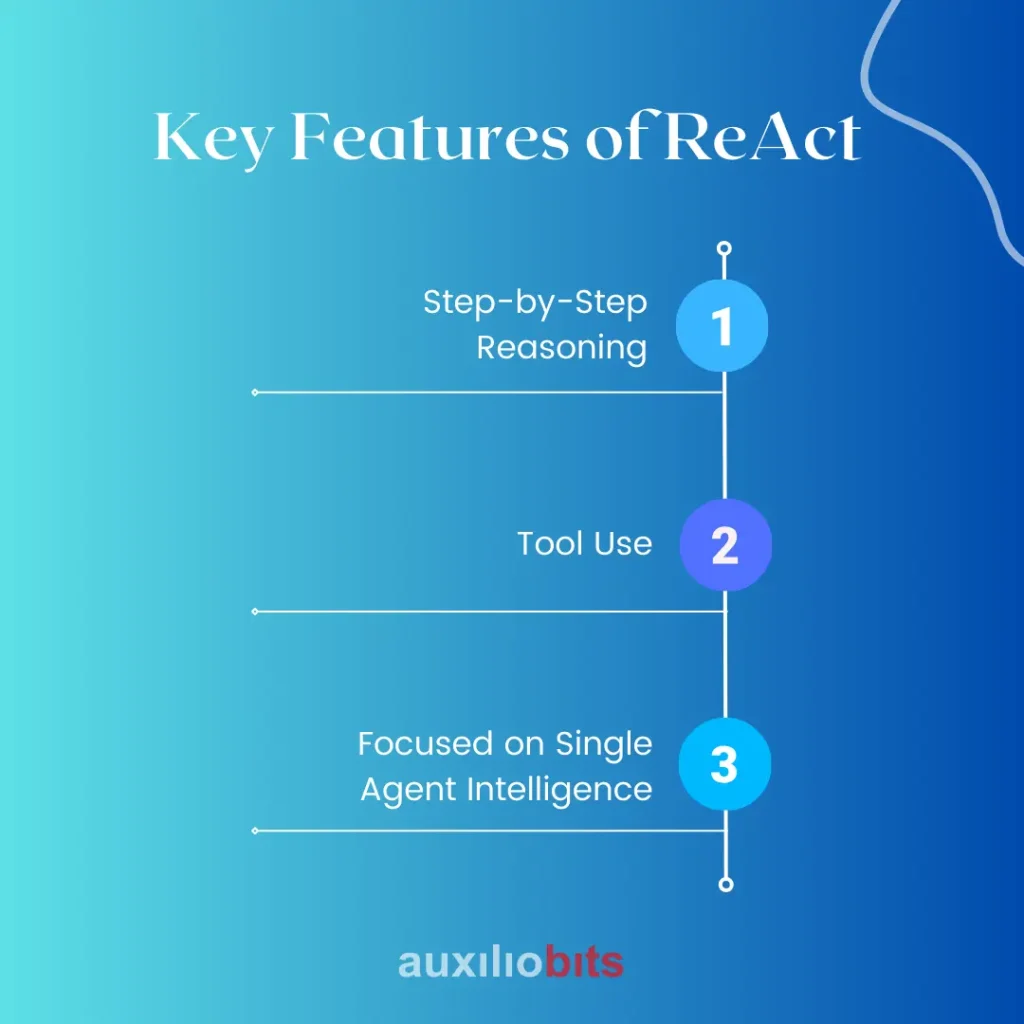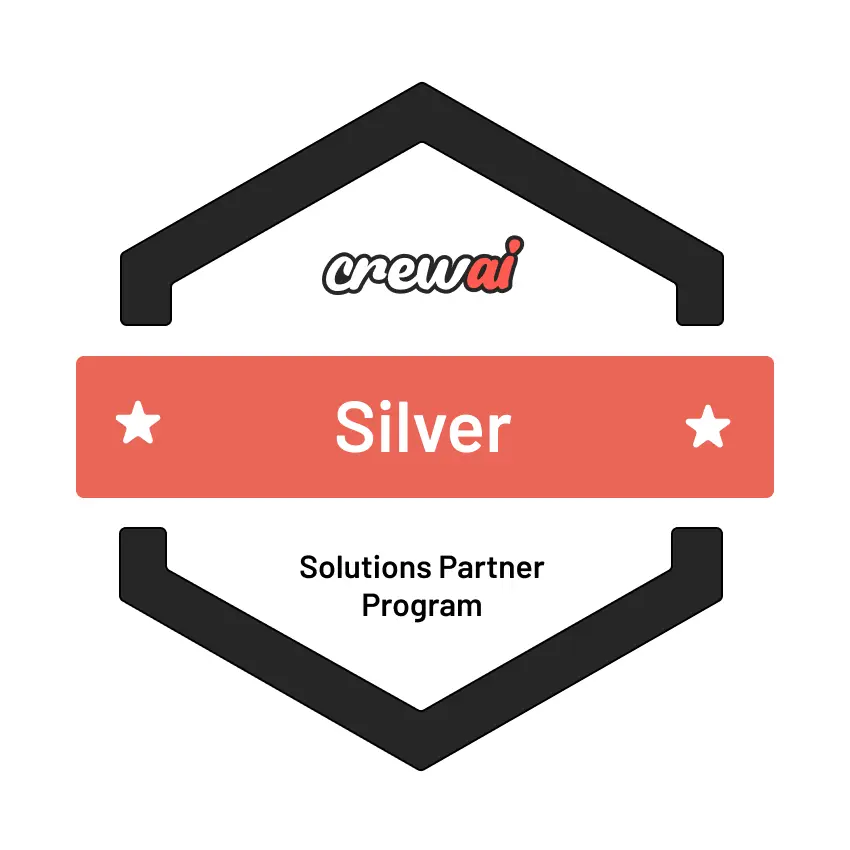
Key Takeaways
- AI agents are autonomous software entities that plan, reason, and act independently or collaboratively. They enable more dynamic and intelligent task execution than traditional rule-based systems.
- CrewAI provides a team-based framework where agents have defined roles, such as researcher or reviewer. This makes it ideal for orchestrating multi-step, specialized workflows like content creation or customer support.
- ReAct agents combine reasoning and action in a step-by-step loop, using tools and logic to solve complex problems autonomously—ideal for tasks like technical support or data analysis.
- CrewAI is best used when tasks are complex, require specialization, and benefit from inter-agent communication. It is excellent for repeated, collaborative workflows with multiple task-specific agents.
- You can combine CrewAI’s structured multi-agent orchestration with ReAct’s intelligent, tool-using agents to build hybrid systems that are both scalable and capable of deep, autonomous reasoning
As artificial intelligence continues to go above and beyond to push the limits of what machines can do, a new frontier has emerged: agent-based AI. These are intelligent systems where independent software components think, plan, and act. Nevertheless, they function collectively or independently to execute tasks.
This concept marks a significant shift from traditional automation, moving us toward systems that are more adaptive, collaborative, and capable of reasoning through problems in dynamic environments. The core elements of this evolution are the frameworks that can help enterprises and developers build, deploy, and orchestrate these agents. Two very important contenders here are CrewAI and ReAct agents. Each takes pride in offering a special approach to designing agent-based systems.
Also read: What’s New in UiPath 2025: AI Center, Studio Web, and Automation Cloud?
What Are AI Agents?
Before learning about CrewAI and ReAct, let’s explore the central concept behind them: the AI agent. An AI agent is a software entity with the skills to understand the environment, make predictions, and take instant actions. It does not need human assistance to operate, ensuring these agents perform tasks and make informed decisions.
Think of an AI agent as an intelligent digital assistant that doesn’t just wait for commands. It can actively plan, reason, and execute actions based on its objectives. For example, if you ask a traditional bot to book a flight, it might just take your inputs and fill out a form. An AI agent, however, could compare options, factor in your past travel preferences, notify you of better deals, and even coordinate with other agents (like a calendar or expense tracker) to ensure a seamless booking experience.
Agents can work individually or in groups, depending on the complexity of the task. A single agent might be sufficient for a straightforward goal, like summarizing a document. But for more complex scenarios, such as conducting market research, generating a business plan, or troubleshooting a software issue, multiple agents with different roles might collaborate, each bringing a specific skill or perspective.
This collaborative, goal-oriented behavior is what makes agent-based AI so powerful. It enables systems that can reason, plan, and adapt—qualities increasingly essential in today’s dynamic and data-rich environments.
What Is CrewAI?
CrewAI is an open-source framework that makes building intelligent systems with multiple collaborating AI agents easier. Inspired by how human teams work, CrewAI introduces a structure where each agent is given a clear role and purpose, enabling them to function together as a cohesive unit—or “crew”—to complete complex tasks. Rather than relying on a single AI model to do everything, CrewAI emphasizes collaboration, delegation, and specialization, making your AI system more efficient and scalable.
Key Features of CrewAI

1. Role-Based Agents
In CrewAI, each agent is assigned a distinct role based on their purpose in the workflow. For example, roles could include a “Researcher” who gathers data, a “Planner” who organizes it, a “Writer” who creates content, and a “Reviewer” who checks for accuracy and quality. These roles mirror real-world job functions and help agents specialize in specific tasks.
2. Team Structure
Agents in CrewAI operate like a human project team. They know their teammates, understand their roles, and can communicate and coordinate to share progress, ask questions, or delegate subtasks. This team-based structure allows CrewAI systems to tackle complex, multi-step objectives more effectively than isolated agents.
3. Task Delegation and Workflow Management
CrewAI enables dynamic task delegation by orchestrating who does what and when. This allows the system to break down significant goals into smaller components and assign them to the most appropriate agent. The framework handles the hand-offs, ensuring the process flows smoothly from one agent to the next.
Example Use Case: Collaborative Report Generation
Let’s say you need to generate a comprehensive industry report. Here’s how CrewAI can structure the work:
- The Researcher Agent gathers relevant data from articles, databases, and online sources.
- The Writer Agent takes that data and crafts a well-structured draft.
- The Reviewer Agent then proofreads the draft, checks for consistency, and enhances clarity.
This division of labor mirrors how a real content team might operate—each agent focusing on what they do best, and the framework ensuring seamless collaboration.
CrewAI shines in use cases that involve structured workflows, multi-step planning, or coordinated outputs, such as report generation, business planning, customer support, or even AI-driven software development. It brings order, clarity, and teamwork to the world of intelligent agents.
What Are React Agents?
ReAct stands for Reasoning and Acting, a robust approach introduced in a research paper by OpenAI and collaborators. ReAct agents are designed to think and act in a step-by-step loop, allowing them to solve complex tasks through logical reasoning and dynamic action. Unlike traditional AI systems that passively respond with an answer, ReAct agents simulate how humans solve problems by thinking through the question, gathering information, and taking appropriate steps to reach a solution.
This approach is beneficial in tasks where the answer isn’t immediately obvious and requires a combination of thoughtful deduction and interaction with tools or environments.
Key Features of ReAct

1. Step-by-Step Reasoning
ReAct agents don’t rush to a conclusion. Instead, they work through the problem using a logical, step-by-step chain-of-thought process. This helps them maintain transparency in their decision-making and reduces errors caused by shallow or overly direct answers.
2. Tool Use
during their reasoning process. These tools include a calculator, web search, database query, or API call. The agent decides when a tool is needed and how to use it based on the problem.
3. Focused on Single-Agent Intelligence
While multi-agent systems like CrewAI emphasize teamwork, ReAct is typically used to build a single, competent agent. That agent is designed to handle various questions or tasks independently by breaking them down and taking intelligent actions.
Example Use Case: Complex Question Answering H4
Imagine you ask a ReAct agent, “What is the country with the largest population?”
Here’s how it would handle it:
- Reason: “The country with the largest population is China.”
- Act: Perform a search or look it up using a knowledge tool.
- Return: “The capital is Beijing.”
This process shows the agent’s ability to think, verify, and respond within a single intelligent workflow. It benefits research, data analysis, decision support, and technical problem-solving, where questions are layered and require contextual understanding.
Comparing CrewAI and ReAct
Here’s a simple comparison of both frameworks:
| Feature | CrewAI | ReAct Agents |
| Type | Multi-agent system | Single-agent with reasoning |
Focus | Teamwork and coordination | Logical thinking and tool use |
Best for | Complex tasks with different roles | Functions that need step-by-step reasoning |
| Communication | Between multiple agents | Internal (within one agent) |
Flexibility | High (can model any team structure) | High (can solve diverse problems) |
| Tool support | Can use tools if configured | Actively uses tools during reasoning |
When to Use CrewAI?
CrewAI is the right choice when working on a task that is too big or too complex for just one AI agent to handle effectively. It’s built for situations where multiple agents must work together, like team members. If your goal involves breaking down a task into smaller steps and assigning each step to the most suitable “specialist,” CrewAI can help you do that smoothly.
Here are some everyday situations where CrewAI is the best fit:
1. Your Task Has Multiple Specialized Steps
Some tasks can’t be done well by a single agent because they involve different types of work. For example, report writing might require research, content creation, and editing. Each of these steps requires different skills. With CrewAI, you can assign each step to a different agent best suited for that task. This helps improve the final result’s quality, efficiency, and reliability.
2. You Want Agents to Take on Different Roles
CrewAI lets you assign roles to each agent, like “Researcher”, “Planner”, “Writer”, or “Reviewer”. Just like in a real-life team, everyone knows their job. This makes it easier to manage big workflows because each agent stays focused on what they do best. You don’t have to build one super-smart agent to do everything—instead, you make an innovative team.
3. Collaboration Between Agents Is Important
CrewAI is built for teamwork. The agents can communicate, share information, and pass tasks along to each other. This is especially useful when the output of one agent is needed as input for another. For example, a researcher agent might gather data, and then pass it to a writer agent who creates a report, which a reviewer agent finally checks.
4. You’re Building Repeatable Workflows
If you’re automating a process that you repeat often, like generating blog posts, responding to customer requests, or planning a project, CrewAI can help you organize and automate that workflow. Once you define the roles and the steps, you can reuse that setup repeatedly.
Example Projects
Here are some examples of real-world applications where CrewAI works well:
- Marketing Assistant:
Build a content creation crew with three agents:
- A Research Agent finds trending topics and gathers insights.
- A Writer Agent creates the draft.
- An Editor Agent improves the tone and grammar before publishing.
- Customer Service System:
Design a crew with specialized agents:
- A Billing Agent handles payment-related questions.
- A Technical Support Agent helps with troubleshooting.
- A Sales Agent answers product questions and upsells.
In summary, use CrewAI when your automation needs to be structured, team-based, and broken into clear roles. It’s perfect for situations where collaboration, specialization, and coordination are key to doing the job well. If your project looks like a team effort, CrewAI is probably the proper framework.
Can You Use Both CrewAI and ReAct Together?
Yes, absolutely! One of the exciting things about working with AI agents is that you’re not limited to choosing just one framework. Combining CrewAI and ReAct can help you build even more powerful and flexible systems. Each framework has its strengths, and when used together, they complement each other beautifully.
Let’s break it down.
CrewAI is excellent for organizing multiple agents into a structured team. It helps you manage workflows, assign roles, and ensure each agent focuses on a specific part of the task. It’s like having a crew where everyone knows their job—researchers, writers, editors, or customer support reps.
ReAct, on the other hand, is perfect when you need an agent that can think deeply and act smartly on its own. A ReAct agent can break down a complex problem, reason through it step-by-step, and use tools (like search engines or calculators) to get the correct answer. It’s like having a brilliant assistant who doesn’t just follow instructions, but figures things out as they go.
Now, imagine putting these two ideas together.
Example of a Hybrid Setup
You could build a CrewAI system where one agent is a ReAct agent. For example:
- A Researcher Agent (based on ReAct) could handle complex research questions that require reasoning and real-time information gathering.
- That agent could then pass its findings to a Writer Agent in CrewAI, who crafts a blog post.
- Finally, a Reviewer Agent checks the content for accuracy and tone.
This setup gives you the best of both worlds:
- The structure and teamwork of CrewAI
- The flexibility and intelligence of ReAct
Combining them allows you to build organized systems that can handle more dynamic, reasoning-heavy tasks when needed.
Final Thoughts
Both CrewAI and ReAct offer powerful ways to build intelligent agents. The right choice depends on what kind of task you’re solving and how you want your agents to work.
- Use CrewAI when you need teamwork and specialization.
- Use ReAct when you need deep reasoning and tool use by a single agent.
As AI continues to evolve, these frameworks give us more ways to automate complex tasks in more innovative, human-like ways.








